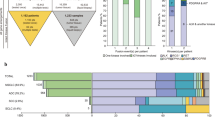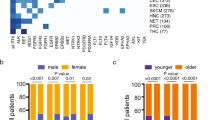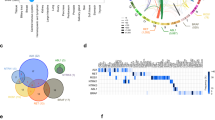Abstract
We identified new gene fusions in patients with lung cancer harboring the kinase domain of the NTRK1 gene that encodes the high-affinity nerve growth factor receptor (TRKA protein). Both the MPRIP-NTRK1 and CD74-NTRK1 fusions lead to constitutive TRKA kinase activity and are oncogenic. Treatment of cells expressing NTRK1 fusions with inhibitors of TRKA kinase activity inhibited autophosphorylation of TRKA and cell growth. Tumor samples from 3 of 91 patients with lung cancer (3.3%) without known oncogenic alterations assayed by next-generation sequencing or fluorescence in situ hybridization demonstrated evidence of NTRK1 gene fusions.
This is a preview of subscription content, access via your institution
Access options
Subscribe to this journal
Receive 12 print issues and online access
$209.00 per year
only $17.42 per issue
Buy this article
- Purchase on SpringerLink
- Instant access to full article PDF
Prices may be subject to local taxes which are calculated during checkout


Similar content being viewed by others
Accession codes
Primary accessions
GenBank/EMBL/DDBJ
Referenced accessions
NCBI Reference Sequence
References
Mok, T.S. et al. N. Engl. J. Med. 361, 947–957 (2009).
Shaw, A.T. et al. N. Engl. J. Med. 368, 2385–2394 (2013).
Davies, K.D. et al. Clin. Cancer Res. 18, 4570–4579 (2012).
Takeuchi, K. et al. Nat. Med. 18, 378–381 (2012).
Ju, Y.S. et al. Genome Res. 22, 436–445 (2012).
Kohno, T. et al. Nat. Med. 18, 375–377 (2012).
Drilon, A. et al. Cancer Discov. 3, 630–635 (2013).
Majewski, I.J. et al. J. Pathol. 230, 270–276 (2013).
Wu, Y.M. et al. Cancer Discov. 3, 636–647 (2013).
Lipson, D. et al. Nat. Med. 18, 382–384 (2012).
Alberti, L., Carniti, C., Miranda, C., Roccato, E. & Pierotti, M.A. J. Cell Physiol. 195, 168–186 (2003).
Davies, K.D. & Doebele, R.C. Clin. Cancer Res. 19, 4040–4045 (2013).
Peifer, M. et al. Nat. Genet. 44, 1104–1110 (2012).
Stephens, R.M. et al. Neuron 12, 691–705 (1994).
Surks, H.K., Richards, C.T. & Mendelsohn, M.E. J. Biol. Chem. 278, 51484–51493 (2003).
Soda, M. et al. Nature 448, 561–566 (2007).
Busch, R., Doebele, R.C., Patil, N.S., Pashine, A. & Mellins, E.D. Curr. Opin. Immunol. 12, 99–106 (2000).
Rikova, K. et al. Cell 131, 1190–1203 (2007).
Awad, M.M. et al. N. Engl. J. Med. 369, 1173 (2013).
Martin-Zanca, D., Hughes, S.H. & Barbacid, M. Nature 319, 743–748 (1986).
Seo, J.S. et al. Genome Res. 22, 2109–2119 (2012).
George, D.J. et al. Cancer Res. 59, 2395–2401 (1999).
Cui, J.J. et al. J. Med. Chem. 54, 6342–6363 (2011).
Gnirke, A. et al. Nat. Biotechnol. 27, 182–189 (2009).
Li, H. et al. Bioinformatics 25, 2078–2079 (2009).
McKenna, A. et al. Genome Res. 20, 1297–1303 (2010).
Zhou, W. et al. Nature 462, 1070–1074 (2009).
Berger, M.F. et al. Genome Res. 20, 413–427 (2010).
Kim, D. et al. Genome Biol. 14, R36 (2013).
Doebele, R.C. et al. Clin. Cancer Res. 18, 1472–1482 (2012).
Helfrich, B.A. et al. Clin. Cancer Res. 12, 7117–7125 (2006).
Davies, K.D. et al. Clin. Cancer Res. 18, 4570–4579 (2012).
Marek, L. et al. Mol. Pharmacol. 75, 196–207 (2009).
Pitts, T.M. et al. Front Pharmacol. 4, 35 (2013).
Oie, H.K. et al. J. Cell Biochem. Suppl. 24, 24–31 (1996).
Sasaki, T. et al. Cancer Res. 71, 6051–6060 (2011).
Acknowledgements
This work was supported by the Colorado Bioscience Discovery Evaluation Grant Program, the National Institutes of Health (NIH) NCATS Colorado Clinical and Translational Sciences Institute Grant UL1 TR000154 (contents are the authors' sole responsibility and do not necessarily represent official NIH views) and the Boettcher Foundation's Webb-Waring Biomedical Research Program (R.C.D.), as well as the Dana-Farber/Harvard Cancer Center Lung Cancer Specialized Programs of Research Excellence (SPORE) P50 CA090578 (P.A.J.), the Cammarata Family Foundation Research Fund (M.C. and P.A.J.), the Nirenberg Fellowship at the Dana-Farber Cancer Institute (M.C. and P.A.J.) and the University of Colorado Lung Cancer SPORE grant P50CA058187 and the US National Cancer Institute Cancer Center Support Grant P30CA46934 (M.V.-G.). Ba/F3 cells were a gift from D. Theodorescu (University of Colorado, Anschutz Medical Campus). The cell lines KM12, HCT116, HCT15, HT29 and SW837 were gifts from S.G. Eckhardt (University of Colorado, Anschutz Medical Campus). The cell lines H3122, H1650, H1299 and HCC78 were gifts from J.D. Minna (University of Texas Southwestern). Aythymic nude mice were a gift from J. DeGregori (University of Colorado, Anschutz Medical Campus).
Author information
Authors and Affiliations
Contributions
R.C.D., P.A.J. and V.A.M. conceived of the research idea. R.C.D. and P.A.J. designed experiments, took responsibility for the oversight of the project and wrote the manuscript. A.V. and D.E. designed and performed immunoblotting, generated Ba/F3 and NIH3T3 cells expressing exogenous NTRK1 fusion constructs, performed flow cytometry and MTS assays and contributed to writing of the manuscript. D.L. and P.J.S. designed and performed NGS assays. M.V.-G. designed FISH probes and interpreted FISH experiments. S.K. and S.M. performed and analyzed FISH experiments. A.T.L. and M.C. performed cloning of RT-PCR fusion constructs. D.L.A. analyzed tumor samples and performed immunohistochemistry. K.D.D. performed in vitro analyses and contributed to interpretation of the data. A.B.P. performed in vivo experiments and contributed to interpretation of data. P.S.H., L.A.G. and G.K. performed bioinformatics analyses. J.H. and S.W.A. designed and profiled ARRY-470. E.M.B. and M.B. collected clinical data. J.K., H.S. and S.P. provided subject specimens. All authors contributed to revision of the manuscript.
Corresponding authors
Ethics declarations
Competing interests
R.C.D., M.V.-G. and A.T.L. are listed on a regularized patent application filed with the U.S. Patent and Trademark Office related to NTRK1 as a predictive biomarker in cancer.
Supplementary information
Supplementary Text and Figures
Supplementary Figures 1–20 (PDF 14573 kb)
Supplementary Tables
Supplementary Tables 1–4 (PDF 261 kb)
Rights and permissions
About this article
Cite this article
Vaishnavi, A., Capelletti, M., Le, A. et al. Oncogenic and drug-sensitive NTRK1 rearrangements in lung cancer. Nat Med 19, 1469–1472 (2013). https://doi.org/10.1038/nm.3352
Received:
Accepted:
Published:
Issue Date:
DOI: https://doi.org/10.1038/nm.3352



